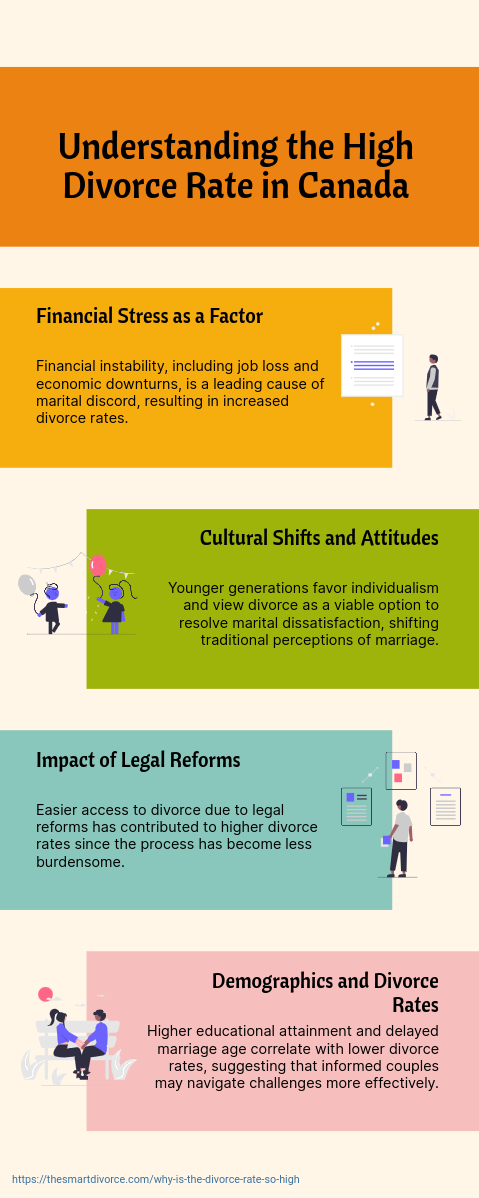Divorce rates in Canada have undergone significant changes over the last 50 years, prompting the question, why is the divorce rate so high, and making it essential to understand the factors behind these shifts. While it might seem that divorce is becoming less common, the reality is more complex. Fewer people are getting married, and for those who do, divorce is often seen as an unaffordable option. In this blog post, we’ll explore why is the divorce rate so high, focusing on economic factors such as rising divorce costs, living expenses, and global comparisons to understand how Canada stacks up.
The Declining Divorce Rate: A Surprising Statistic
In 2020, Canada’s divorce rate hit its lowest point in 50 years, with just 5.6% of married people divorcing per 1,000. This decline is not necessarily a sign of happier relationships but reflects fewer marriages overall, raising the question why is separation more common? In 2021, only 44% of Canadians over 15 were married, compared to 54% in 1991. This trend naturally lowers the divorce rate, prompting questions like why do so many couples part ways, and why are fewer Canadians getting married?
Economic Barriers to Marriage and Divorce
One of the biggest reasons for the decline in both marriage and divorce is economic hardship. Divorce is becoming increasingly unaffordable for many Canadians, with the average cost now around $18,000. Legal fees, court appearances, and asset division can quickly add up, especially when the divorce is contested. Beyond divorce costs, everyday expenses like rent and groceries make it challenging to maintain two separate households post-divorce, forcing some couples to stay together out of financial necessity, which might help explain why do couples split more nowadays.
- Housing Costs: Rent for a modest townhouse in a decent area often exceeds $3,000 a month, making it nearly impossible for one person to manage a household alone. Financially strained couples may decide to stay together purely because they cannot afford to live separately.
- Rising Living Expenses: In addition to housing costs, the price of essentials like food, utilities, and childcare has skyrocketed, leaving couples financially stretched. Splitting up only worsens the financial strain, so many opt to stay in the relationship even when emotional ties weaken.
Global Comparisons: How Does Canada Stack Up?
Canada stands out among G7 countries with the highest rate of common-law couples, where people live together without getting married. This shift towards cohabitation without legal marriage makes divorce rates lower but doesn’t eliminate the challenges couples face when they part ways.
When compared to other countries, we see similar trends:
- United States: Divorce rates are also declining due to rising living costs and the prohibitive expenses of divorce. While the U.S. marriage rate is higher than Canada’s, financial instability has led many couples to stay together out of practicality rather than emotional fulfillment.
- European Countries: Countries like France and the U.K. have seen similar trends, though they have implemented more affordable and streamlined divorce processes. These systems reduce the financial burden of separating couples, which is less common in Canada.
The Historical Rise in Divorce Rates
From the 1950s to the 2000s, divorce rates in Canada soared, raising the question of why do so many couples part ways during this period. In 1951, there were only 5,270 divorces, but by 2008, that number skyrocketed to over 70,000. Contributing factors included:
- Progress in Family Law: The introduction of no-fault divorces and legal reforms made it easier to dissolve marriages.
- Diminishing Social Stigma: Divorce became more socially acceptable, reducing the pressure to stay in unhappy marriages.
- Changing Expectations: Modern marriages are based more on personal fulfillment than the “companionate” marriages of the 1950s, emphasizing teamwork and practical partnership. As expectations shifted, dissatisfaction became a common reason for divorce.
The Unaffordable Reality of Divorce in Canada
Divorce is not only emotionally taxing but also financially draining. Although the legal system has improved over time, the cost of divorce remains a significant hurdle. Once a couple separates, they often find it difficult to maintain two households on what previously supported one. This economic reality keeps many couples in relationships longer than they might have otherwise chosen, as divorce becomes a luxury many cannot afford.
Are Common-Law Relationships the Future?
With marriage rates declining and divorce becoming less accessible, many Canadians are choosing common-law relationships. These partnerships allow couples to live together and share a life without the formalities and financial risks of marriage. Canada’s high rate of common-law relationships is a testament to the broader societal shift towards non-traditional relationships, a shift that many of us are part of. However, common-law separations still involve legal issues like property division and child custody, often creating challenges similar to those married couples face.
Evolving Attitudes Toward Marriage and Divorce
As societal attitudes continue to shift, marriages are seen less as a requirement and more as a choice based on personal satisfaction. The rise of individualism has led to a focus on self-fulfillment within relationships, with many couples prioritizing emotional well-being over traditional norms, possibly answering why are splits increasing. Divorce is no longer taboo, but its financial barriers prevent many from taking that step.
How a Divorce Coach Can Help
As a Divorce Coach, I help couples navigate this challenging landscape. Whether you’re contemplating divorce or just struggling to understand the financial and emotional toll of separation, a Divorce Coach can guide you through:
- Emotional Support: Separation is not just a legal process but an emotional one. A Divorce Coach helps you manage guilt, anger, and confusion, empowering you to make clear-headed decisions.
- Practical Guidance: From budgeting for a divorce to understanding your rights in a common-law separation, I can offer actionable advice that helps ease the financial burden of divorce.
- Communication and Conflict Resolution: Many marriages fail due to a communication breakdown. Working with a Divorce Coach can help you improve communication and even explore alternatives like mediation before deciding to divorce.
Understanding the Future of Marriage and Divorce
The declining divorce rate in Canada reflects more than just happier marriages; it shows the growing financial obstacles that make marriage and divorce less accessible, addressing factors contributing to rampant divorces. As more Canadians choose common-law relationships and cohabitation, traditional marriage continues to evolve. However, the financial burdens of staying married and getting divorced create new challenges for couples.
By staying informed and seeking support, you can make better choices for your relationship. Whether you’re considering divorce or need help understanding your options, a Divorce Coach can be an invaluable resource during this change. Remember, you are not alone in this journey. With the right information and support, you can navigate the complexities of marriage and divorce with confidence.
Final Thoughts: Why is the Divorce Rate So High
Divorce is a complex process that impacts the people involved and their entire family. As a Divorce Coach, I often see women, men, and children grappling with the emotional, financial, and legal consequences of a marriage’s end. Family law ensures that each spouse is treated fairly during this process, but it’s important to remember that every case is unique.
Common reasons for divorce range from irreconcilable differences to more severe issues like domestic violence and substance abuse, which put both men and women at risk. In some cases, violence and abuse are the primary reasons for seeking a divorce, and in such instances, it’s critical to seek legal help immediately. Domestic violence is a serious concern in our society, and it’s one of the leading factors that pushes individuals to file for divorce.
When considering separation, it’s essential to know that divorce lawyers and family law professionals can help guide you. Still, a Divorce Coach can assist with the emotional toll every step of the way. Whether you’re trying to work out common issues like property division or child custody or facing a more contentious split, the guidance of a coach can help you navigate today’s complex divorce landscape.
It’s also important to understand that not all divorces are alike. For instance, first marriages have a higher success rate compared to second or third marriages, and religious affiliation can sometimes make couples more likely to stay together. But for those who do choose to end their marriages, the divorce statistics are telling. Canada, for instance, has one of the highest divorce rates among 1,000 people compared to globally, though the crude divorce rate has declined in recent years. Divorce statistics also show that rising costs and financial instability are common reasons why couples feel compelled to either divorce or remain in unhappy marriages.
Another factor to consider is the financial burden that comes with separation. Rising divorce rates in some areas can be attributed to rising living costs, making it hard for one person to manage household expenses alone. For those contemplating divorce, seeking a free consultation with legal professionals to explore your options is wise.
At the end of the day, every individual must decide for themselves what their future holds. Whether your spouse has filed for divorce or you are considering it yourself, know that resources are available to help you. Certain factors, like whether you live together or have children, can complicate things, but taking the time to understand what marriage entails and why you’ve reached this point is essential.
Divorce doesn’t have to be the end of happiness; it can often be the beginning of a new chapter. With the proper support, you can navigate the risks and challenges, whether it’s your first or third time facing divorce. No matter your circumstances, you deserve to feel empowered and informed as you make decisions about your life and future.
At The Smart Divorce
We understand that the decision to end a marriage is always challenging. The rising divorce rates in Canada reflect evolving societal attitudes and the complexities of modern relationships, answering queries such as what makes separation so prevalent. But you’re not alone in this journey. At The Smart Divorce, we provide the guidance and support you need, fostering open communication and understanding of your needs. You can find comfort in knowing that we are here for you.
At The Smart Divorce, we recognize the emotional turmoil and life changes that come with this decision. Our professionals provide guidance and support, fostering open communication and understanding of individual needs.
You’ve come to us seeking answers and guidance. We’re here to help, providing a safe space for your concerns. We aim to empower you with the knowledge and tools to make informed decisions about your future.
Every step towards understanding and healing is a step away from becoming another statistic. We encourage you to reach out and learn how we can assist you.
During the ‘Get Acquainted Call ‘, you’ll have the opportunity to share your concerns and ask any questions you may have. This call, which typically lasts [30 minutes], is designed to help you understand how we can assist you and to ensure that our services are the right fit for your needs.
Together, we can navigate this life transition, helping you move towards a future of growth and fulfillment. At The Smart Divorce, we’re a community ready to support you every step of the way, providing the guidance and support you need to make informed decisions about your future.
Identifying Divorce Drivers
Major causes of high divorce rates include financial pressures, infidelity, lack of commitment, and growing individualism.
Canada’s Rising Divorce Rate
The divorce rate in Canada has been increasing due to several complex factors, including changes in societal norms, financial pressures, and the evolving roles of spouses within marriage.


